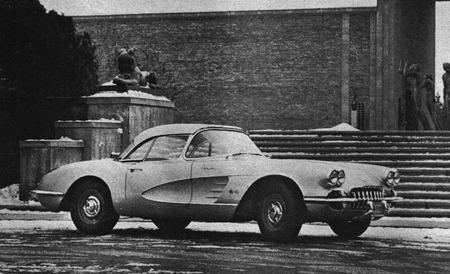Originally published in Sports Cars Illustrated in March 1959.
Having carefully selected our list, we were pleasantly surprised to find that the Chevrolet Division could put such a sample at our disposal immediately. Seems a fellow named Arkus-Duntov has a company car fitted out identically but for one exception. His car also has the quick-steering adaptor (3.25 instead of 3.7 turns lock to lock). Generally available only as part of the heavy-duty suspension kit, it’s worthwhile on its own if you can stand the noticeably stiffer steering. And if you can get it.
Omitted from our list were the heavy duty brake and suspension kits. For 1959, the heavy duty suspension features much stiffer springs than last year. In pounds-per-inch, the spring rate on the standard suspension, last year’s HD kit and this year’s are, respectively, 300, 340 and 550 at the front and 115, 125 and 145 at the rear. Though the kit’s anti-roll bar diameter remains at 13/16-inches, the vast increase in spring stiffness contributes to both much flatter turns and much harsher bouncing. Nice for racing only, but not for the all-around usage we have in mind.
Corvette cornering has been the butt of many rude remarks by the anti-roll brigade. Duntov had interesting thoughts on this matter too. “For flat, smooth courses, such as Le Mans or Sebring,” he said, “the heavy duty suspension option is very effective. But because it is so much stiffer, especially in roll, it would actually be a hindrance on a bumpy circuit such as the Nürburgring.” An interesting thought, and interesting examples, too.
With so much power so freely available, rapid cornering necessarily becomes a maneuver requiring careful control of all the elements involved.
Though a stiffer anti-roll bar would reduce the independency of the front end, the reduction in roll would certainly promote more driver security. The experimental seats helped, so did the seat belts.
The steering, stiff for parking, was fine for controlling incipient slides, but as before, we found the throttle linkage much too sensitive. As a result, the car again appears to have two personalities. Either you motor sedately (though deceptively quickly) through a corner, or pressing on somewhat, you’re herding an untamed beast, one which responds more to the throttle than the wheel, and rather violently, at that.
In making up our list, the Cerametalix brake linings lost out as being entirely unsuited to highway use. When cold, they grab violently and erratically. Besides, they come only with the HD suspension.
Using regular drums, the sintered metallic brake linings at only $26.90 are so good and so cheap that they should be standard equipment. Though the 15ð F. temperature during our test helped their heat dissipation, it gave us a chance to prove that they have no nasty habits when cold. Being inorganic, they don’t soak up water either.
Flared drums, standard on all Chevies this year, have a bell rim-like flange which helps scoop air in from the inboard side. Between these and the linings, we repeatedly made stops from 90 and over without a trace of fade or increase in pedal travel. Pedal pressure, though, is higher than with organic (asbestos) linings. Running against a mild breeze, we managed zero to 100 mph and back to a standstill in 26.4 seconds, a figure that could be improved upon with experience.
Though it runs $484.20 more than the standard engine, we were anxious to see what the fuel-injected, hot cam V8’s 290 horsepower felt like in a roadable Corvette. To its great credit, it must be mentioned that cornering antics have no effect whatsoever on throttle response. This is in great contrast to quad-equipped cars, whether single or dual. They will just plain quit in the middle of a hard corner.


Leave a Reply